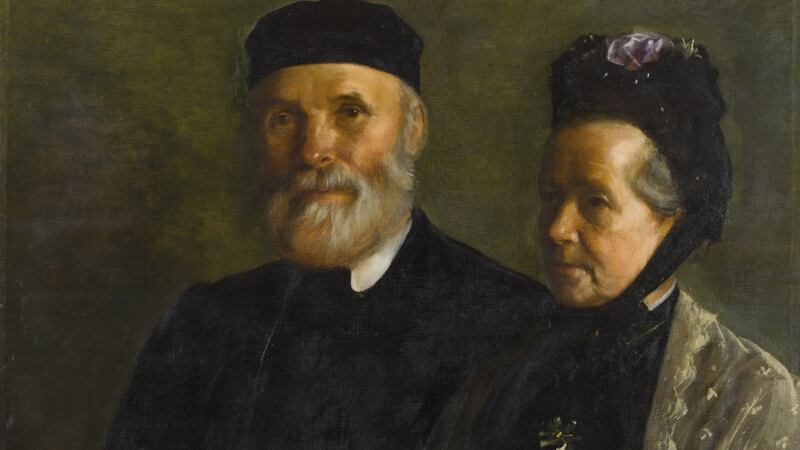Sarah Cecilia Harrison (1863-1941) was a compelling woman who broke new ground – as an artist, an activist, a suffragist and as the first woman to be elected as a city councillor for Dublin in 1912.
Harrison came from a prosperous Northern Irish Protestant family, which was steeped in politics. The family had a strong nationalist inclination and she was a grand-niece of the United Irishman, Henry Joy McCracken, and his sister, Mary Ann McCracken, a radical and philanthropist. Both Harrison and her brother Henry Harrison were staunch supporters of the campaign for Irish Home Rule. Henry was just 22 years old when he was elected as MP for mid-Tipperary and he became a nationalist celebrity overnight and one of Parnell’s closest allies.
After the death of Harrison’s father in 1873, the family relocated to London. At the age of 15, Harrison enrolled in the recently established Slade School of Art where she spent the next seven years, and learned the craft of painting. Her talent as an artist was noted from her early training at the Slade, where she won several prizes and medals.

Her teacher was the renowned French artist, Alphonse Legros, with whom she developed a close and enduring friendship. The Slade was unusual in that during Harrison’s time there, male and female students were permitted to work in the same studio space, drawing from classical sculpture or draped nude models. Her time there informed the rest of her career as a portrait painter, which she started in London in the late 1880s. She also furthered her artistic development, with visits to museums and galleries in France, Italy and the Netherlands.
Although London-based up until the age of 40, Harrison visited Ireland on a regular basis until she moved to Dublin permanently in 1904. Upon her arrival in the city, she quickly made connections and received commissions to paint portraits of individuals from all walks of life. Her subjects included members of the ruling classes and their progeny; academics; doctors; politicians and activists. She earned herself a reputation as one of Ireland’s leading portraitists and her work was realistic and meticulous, and thus highly praised by fellow artists and in contemporary press reports.
Although she painted from life, her posthumous portraits, most notably of Michael Collins (1924-25) (OPW Collection) and Francis Sheehy Skeffingon (1916) (Hugh Lane Gallery) are well known. Both were painted from photographs and memory. Harrison gifted the portrait of Sheehy Skeffington to his widow, Hannah, and the Collins portrait was gifted to the State in 1925, where it hangs in the office of the Taoiseach to this day.

In Dublin, Harrison became one of the staunchest supporters and closest allies of Sir Hugh Lane (1875-1915), the Irish art connoisseur, collector and dealer, in his campaign for the establishment of a modern art gallery for Ireland. She worked tirelessly on Lane’s behalf and wrote the catalogue of works for the gallery when it opened in its temporary premises in Clonmell House, Harcourt Street in 1908. Harrison’s extensive correspondence on the gallery campaign is housed in the National Library and the National Gallery of Ireland.
In addition to her artistic career, Harrison became well-known for her social activism and involvement in a multitude of philanthropic, political and civic campaigns. She believed that an entitlement to employment, adequate housing and access to modern art, were all compatible aspirations. Her strikingly modern and enlightened approach was married with a strong degree of tenacity, pragmatism and a formidable work ethic.
The range of activities in which she was engaged was quite remarkable. For over three decades, Harrison was a champion of the poor, unemployed and marginalised citizens in Dublin who frequently visited her at home. She was vocal in her criticism of any complacency on the part of the authorities to improve the working and living conditions of the working classes.

Harrison was passionate about the rights of women and the needs of children and saw the tenement crisis as being at the root of many of the city’s problems. As a feminist, she consistently championed women’s rights and was one of the Irish suffrage movement’s most prominent activists, as a campaigner, platform-speaker and organiser until 1918, when Irish women voted in a national election for the first time.
Harrison broke new ground when she became the first female councillor for Dublin Corporation in 1912 and as a councillor for three years, her primary concern was the tenement dwellers and the unemployed. Harrison had a powerful and compelling personality. She was articulate, tenacious and passionate about the causes that she espoused. At almost 6 ft 2 in height and often dressed in black, Harrison was an imposing figure.
She was shrewd too, in her use of the press to raise awareness of her causes and was a regular correspondent and author of articles to many newspapers and journals. This brought her in to conflict with powerful individuals such as William Martin Murphy, the successful Irish businessman who owned the bestselling Irish Daily Independent, among other business interests. He was a formidable opponent, in particular in the campaign for a permanent location for the Municipal Gallery of Art (now Hugh Lane Gallery) and on one occasion, the conflict became so heated that Harrison accosted Murphy on Dame Street.

The breadth of Harrison’s achievements is astounding and the traces of Harrison’s legacy can be found in a multitude of places around Dublin city. Her paintings hang in the Hugh Lane Gallery, the National Gallery, National Maternity Hospital, Royal College of Surgeons, the Law Library and City Hall. The Haslam Memorial Bench in St Stephen’s Green, that many pass by daily, is thanks to Harrison who instigated a campaign to have a permanent memorial to Anna and Thomas Haslam, the prominent social reformers and advocates of women’s rights, in recognition of their public service in the “enfranchisement of women”.
Harrison's contribution and achievements have largely been erased from both history and memory and her contribution to the city of Dublin in several different spheres has been overlooked and forgotten. This new publication on Harrison seeks to highlight her legacy as a significant political pioneer, an accomplished portraitist and a tireless campaigner. Harrison died on July 23rd, 1941 at the age of 78. Her tombstone in Mount Jerome cemetery reads "Artist and Friend of the Poor" – a succinct epitaph for a woman who achieved so much in her life.
Sarah Cecilia Harrison (1863-1941): artist, social campaigner and city councillor is published by Dublin City Council










